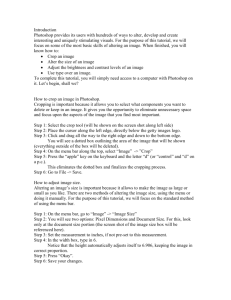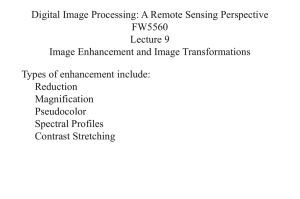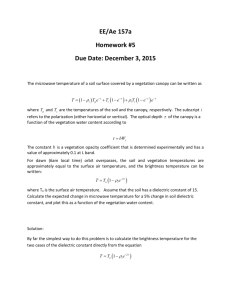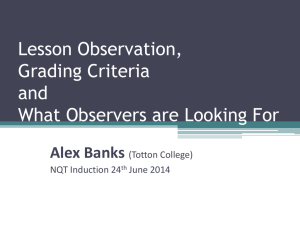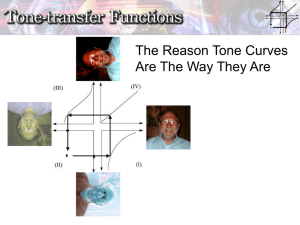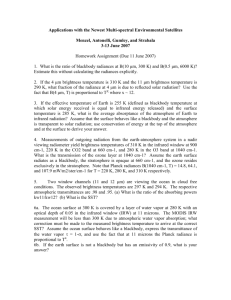693OP60-Schanda-Vidovszky
advertisement
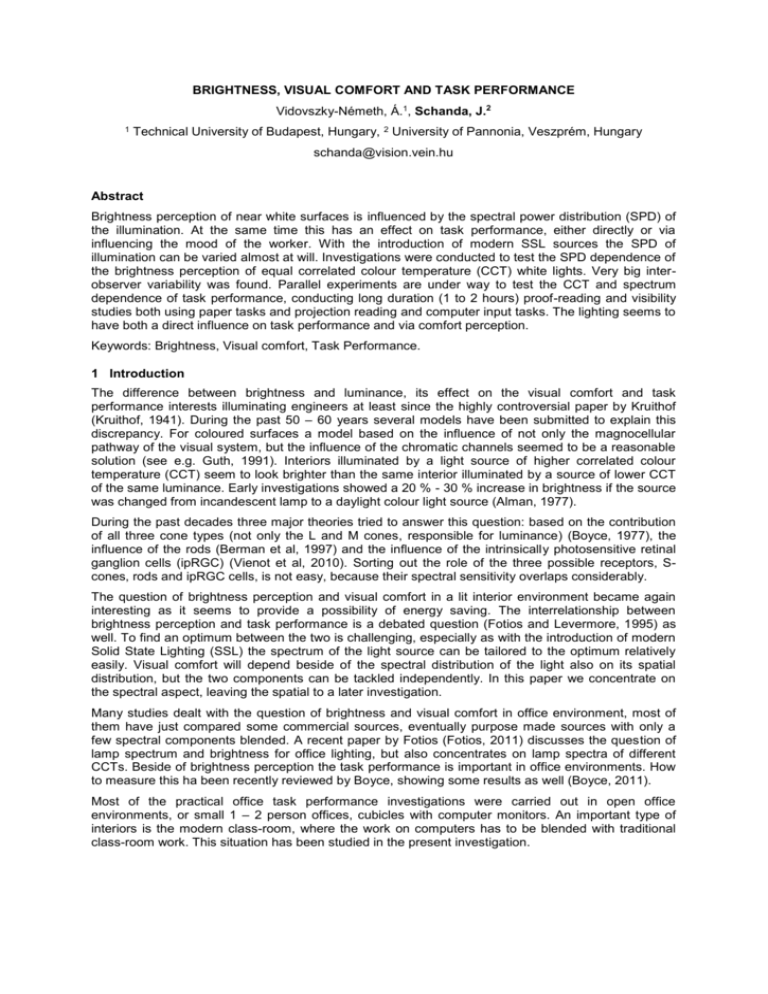
BRIGHTNESS, VISUAL COMFORT AND TASK PERFORMANCE Vidovszky-Németh, Á.1, Schanda, J.2 1 Technical University of Budapest, Hungary, 2 University of Pannonia, Veszprém, Hungary schanda@vision.vein.hu Abstract Brightness perception of near white surfaces is influenced by the spectral power distribution (SPD) of the illumination. At the same time this has an effect on task performance, either directly or via influencing the mood of the worker. With the introduction of modern SSL sources the SPD of illumination can be varied almost at will. Investigations were conducted to test the SPD dependence of the brightness perception of equal correlated colour temperature (CCT) white lights. Very big interobserver variability was found. Parallel experiments are under way to test the CCT and spectrum dependence of task performance, conducting long duration (1 to 2 hours) proof-reading and visibility studies both using paper tasks and projection reading and computer input tasks. The lighting seems to have both a direct influence on task performance and via comfort perception. Keywords: Brightness, Visual comfort, Task Performance. 1 Introduction The difference between brightness and luminance, its effect on the visual comfort and task performance interests illuminating engineers at least since the highly controversial paper by Kruithof (Kruithof, 1941). During the past 50 – 60 years several models have been submitted to explain this discrepancy. For coloured surfaces a model based on the influence of not only the magnocellular pathway of the visual system, but the influence of the chromatic channels seemed to be a reasonable solution (see e.g. Guth, 1991). Interiors illuminated by a light source of higher correlated colour temperature (CCT) seem to look brighter than the same interior illuminated by a source of lower CCT of the same luminance. Early investigations showed a 20 % - 30 % increase in brightness if the source was changed from incandescent lamp to a daylight colour light source (Alman, 1977). During the past decades three major theories tried to answer this question: based on the contribution of all three cone types (not only the L and M cones, responsible for luminance) (Boyce, 1977), the influence of the rods (Berman et al, 1997) and the influence of the intrinsically photosensitive retinal ganglion cells (ipRGC) (Vienot et al, 2010). Sorting out the role of the three possible receptors, Scones, rods and ipRGC cells, is not easy, because their spectral sensitivity overlaps considerably. The question of brightness perception and visual comfort in a lit interior environment became again interesting as it seems to provide a possibility of energy saving. The interrelationship between brightness perception and task performance is a debated question (Fotios and Levermore, 1995) as well. To find an optimum between the two is challenging, especially as with the introduction of modern Solid State Lighting (SSL) the spectrum of the light source can be tailored to the optimum relatively easily. Visual comfort will depend beside of the spectral distribution of the light also on its spatial distribution, but the two components can be tackled independently. In this paper we concentrate on the spectral aspect, leaving the spatial to a later investigation. Many studies dealt with the question of brightness and visual comfort in office environment, most of them have just compared some commercial sources, eventually purpose made sources with only a few spectral components blended. A recent paper by Fotios (Fotios, 2011) discusses the question of lamp spectrum and brightness for office lighting, but also concentrates on lamp spectra of different CCTs. Beside of brightness perception the task performance is important in office environments. How to measure this ha been recently reviewed by Boyce, showing some results as well (Boyce, 2011). Most of the practical office task performance investigations were carried out in open office environments, or small 1 – 2 person offices, cubicles with computer monitors. An important type of interiors is the modern class-room, where the work on computers has to be blended with traditional class-room work. This situation has been studied in the present investigation. 2 Brightness to luminance ratio investigations To be able to select the most effective light source for the one-to-one scale class room environment first double booth experiments were conducted to study fundamental brightness issues. In the following three such experiments will be described. 2.1 Pilot experiment Anecdotic findings pointed into the direction that differences might be observable in the brightness/luminance ratio of RGB and RGB+A LED combinations if the dominant wavelength of the blue LED is changed. Two LED combinations set to the same CCT of 4785 K, with slightly different SPD - as shown in figure 1 - were mounted in a double booth. Both LED combinations had a general colour rendering index of above 80. 12 observers participated in the experiment, where in the booths with medium grey walls white non-fluorescent filter papers were placed on black backing surfaces. The observers had to equate by the help of a mechanical system that changed the position of the LEDs above an opal screen in one of the booths the observed brightness of the two paper sheets after a few minutes of dark adaptation. 5.00E-07 4.50E-07 radiance, W/(sr.m2) 4.00E-07 3.50E-07 3.00E-07 2.50E-07 Booth 1 2.00E-07 Booth 2 1.50E-07 1.00E-07 5.00E-08 0.00E+00 400 450 500 550 600 650 700 wavelength, nm Figure 1. SPDs of the two LED combinations as reflected from the white papers in the double booth. The test supposition was that if the ipRGCs have an influence on the brightness perception that might manifest itself by a difference in the brightness of the samples in the two booths. Calculations were performed by folding the S-cone spectral sensitivity and the ipRGC spectral sensitivity functions with the SPDs of the two LED combinations and comparing this to the luminance of the two LED combinations. A difference was observed compared to the visual observations. Figure 2 shows the L-, M-, S-cone fundamental spectral sensitivities, and the ipRGC sensitivity according to Gall’s estimate (Gall, 2004). Folding these with the SPDs of the two LED combinations measured with an Instrument System CAS spectroradiometer with radiance measuring head 1 and summing up for the visible spectrum, the following results were obtained. 1 One of the authors is indebted to Instr. Syst. for donating the equipment. rel. sensitivity, arb. units 1 0.9 0.8 0.7 0.6 0.5 0.4 0.3 0.2 0.1 0 Gall-Circ l¯(λ) m¯(λ) s¯(λ) 350 400 450 500 550 600 650 700 wavelength, nm Figure 2. Spectral sensitivities of the human cone fundamentals and the ipRGC according to Gall. For the LED combination in booth 1 the circadian efficiency was 6 % higher than for the LED combination in booth 2. (Changing the panels in the two booths showed that this effect was independent of the booth construction and depended only on the LED combinations.) The visual experiments with 12 observers showed a big inter-observer scatter: some observers regarded, for equal luminance, the sample in booth 1 as brighter, some others the sample in booth 2. The divergence of observers was not unexpected, as e.g. Sanders and Wyszecki (Sanders and Wyszecki, 1964) found for coloured stimuli 50 % to 100 % differences between observers’ brightness to luminance ratio (B/L) estimate. As for the selected SPDs the objective difference between the ipRGC excitation to luminance and the S-cone excitation to luminance ratios were small, for further investigations spectra were selected with larger differences. 2.2 Binary LED mixtures As can be seen from figure 2 if one would like to find out whether S-cone fundamental excitation or ipRGCs excitation has an effect on brightness perception, the blue LED spectrum should be selected in the blue-green spectral region. We selected a cyan coloured LED and a deep red one, the light of the two could be mixed additively to produce a white light of 3300 K colour temperature, see figure 3. Due to the courtesy of Zumtobel-Hungary2. we could use a tuneable white light lamp as a broad band reference source that consisted of phosphor converted white LEDs and blue and red LEDs, where the blue LED had maximum emission at 450 nm, thus far from that of the blue LED of the two LED composition The spectra of the two so constructed illuminants are seen in figure 4. The big difference in the blue emission in wavelength is well visible. To be able to quantify these differences the following integrals were calculated: 780𝑛𝑚 𝑋=∫ 𝑆(𝜆)𝑥(𝜆)d𝜆 380 𝑛𝑚 where S(λ) is the SPD of one of the LED assemblies and x(λ) stands for one of the spectral sensitivities (circadian, visibility, etc.). The relative radiances in the Circadian band, the S-cone sensitivity band and the rod-sensitivity band, compared to the luminous flux are seen in Table 1. 2 Authors are indebted to Zumtobel-Hungary for lending this demonstration source. y 0.9 0.8 0.7 0.6 0.5 0.4 0.3 0.2 0.1 0 Sp.locus 0 0.2 0.4 x 0.6 0.8 rel. intensity, arbitr. units Figure 3. CIE chromaticity diagram with Planck locus and the possible mixtures of the selected 2 LEDs. 1.00 0.90 0.80 0.70 0.60 0.50 0.40 0.30 0.20 0.10 0.00 2LED Zumtobel 400 450 500 550 600 650 700 wavelength, nm Figure 4. Spectral power distribution of the two LED sources in binary LED experiment. For the experiments where the 2 LED combination was used, the lower part (side walls and bottom) of both booths was lined with black velvet paper, in the middle of the bottom the four times folded nonfluorescent white filter paper was placed. Observers could see only a black and white scene, no coloured objects were visible. The two booths were placed in a dark room. Pilot experiments have shown that the right/left placement of the booths or of the LED combinations within the booths made no difference in the observations. 25 observers conducted visual experiments with these two sources, among these three were younger than 35 years of age and nine were above 65 years of age. Observers had the task to signal in which of the booths they observed higher brightness of the non-fluorescent white filter paper, while the person, who conducted the experiment increased, or decreased the current of the 2 LED system by the help of a digital power supply, bracketing the “equal brightness” current value. When an observer was content with brightness equality the illuminance at the bottom of the booths was measured with an illuminance meter with an f1’value smaller that 1.4. Table 1. Relative power in the circadian-, S-cone and Rod sensitivity bands compared to the luminous flux for the 2 LED and “Zumtobel” combinations LED source 2 LED combination Zumtobel adjustable source Circadian/lum.flux 0,73 S-cone/lum.flux 0,22 rod/lum.flux 1,1 0,39 0,23 0,56 Four persons (one below 35 years, three within the 36 to 65 years age group) found the 2 LED illumination brighter (i.e. found brightness equality for lower 2 LED combination illuminance). On the average they have set in the 2 LED compartment an illuminance that was 86 % of the illuminance in the “Zumtobel” compartment The inter-observer variability was only ±2%. The majority of observers (15 persons, one below 35 years of age and four above 65 years of age) found brightness equality if the 2 LED compartment was by 21 % ±10 % higher illuminated. Six persons (one below 35 years of age and one above 65 years of age) found equal brightness within a ±5 % range that can be regarded as intra-observer variability. Results are summarized in Table 2. Table 2. Results of brightness comparison of 2 LED and “Zumtobel”source illuminated samples Number of Persons 4 15 6 Rel. brightness (2 LED/”Zumt.” 0,86 1,20 1,02 % st. dev. 2,1 9,9 3,1 As the Zumtobel source was not designed for the present purpose and setting the illuminance values had a larger tolerance, a second experiment was conducted, where the same 2 LED assembly was used, but instead of the Zumtobel lamp a self-assembled LED source was used, that consisted of a blue LED (max at 450 nm), a green LED (max at 520 nm) and three red LEDs (max at 593 nm, 626 nm and 650 nm). The objective values calculated for these LED combinations – in analogy to Table 1 – are shown in Table 3. Table 3. Relative power in the circadian-, S-cone and Rod sensitivity bands compared to the luminous flux for the 2 LED and 5 LED combinations LED source 2 LED combination 5 Led combination Circadian/luminous 0,78 S-cone/luminous 0,25 rod/luminous 1,12 0,46 0,24 0,69 In this experiment 24 observations were made (one observer made several repetitions with a standard deviation of ±5 %). Three observers took part also in the previous experiment, others were different persons. Results of the observations was separated again into three groups: five observations found the 2 LED combination brighter than the 5 LED combinations, and for equal brightness the 2 LED combination had to be set to 82 % of the illuminance of the 5 LED combination 3, with a standard deviation of ±7 %. 15 observers (9 younger as 35 years of age and 2 older that 65 years of age) found the 5 LED combination brighter: the 2 LED combination had to be set to 46 % higher illuminance than the 5 LED combination for equal brightness, but the scatter of results was mach larger: ±32 %. Four observers (2 young ones) have set illuminance in the booths to equal values within ±5 %. Results are shown in Table 4. 3 In reality for this experiment the illuminance of the 5 LED combination was changed by adjusting the currents of the five LEDs by the same proportion. The correlated colour temperature of the illumination did not changed by more than 1 to 2 units in the third decimal. Table 4. Results of brightness comparison of 2 LED and 5 LED source illuminated samples Number of Persons 5 15 4 Rel. brightness (2 LED/5 LED” 0,82 1,46 1,0 % st. dev. 7 32 4 The selected 2 LED combination has quite unique wavelength combinations. Thornton used in his experiments a 500 nm “blue” primary to build his “anti-prime” combination (Thornton, 1992). Although we could show (Csuti and Schanda, 2009) that by using better colour matching functions colours produced by mixing anti-prime primaries can be described properly by CIE colorimetry, some peculiarities still persist: In every experiment we could set the 2 LED combination colorimetrically near to the Planckian locus, in case of the “Zumtobel” reference to about 3100 K, in the 5 LED combination experiment to 3392 K, with Δ(u,v)<310-5, thus very good approximation of the colour temperature; never the less those observers, who found, for equal luminance, the 5 LED combination brighter, reported that the 2 LED combination was slightly greenish, for those, who found the 2 LED combination brighter reported that the 2 LED combination looked “white”. As adaptation white only the two illuminated filter papers could be seen. No further chromatic or achromatic objects were in the field of view, the compartment of the viewing booths was covered with black velvet paper. Further experiments and more detailed investigation of the colour vision of our observers is needed to be able to explain above findings. Some of these are already in progress, see the paper by Csuti and co-workers (Csuti et al, 2011) at this conference. 3 Classroom experiments As the above experiments to find high brightness – low correlated colour temperature sources were still inconclusive, the class room experiments were started by comparing the effect of low and high CCT traditional fluorescent lamps. Many such experiments are described in the literature, see the book by Boyce (Boyce, 2003), or the recent paper by Fotios (Fotios, 2011), our endeavour was to test the effect of light spectrum on medium long term effects, as e.g. fatigue of vision. Tests were conducted in a classroom equipped with computers for the students, with a central videodisplay facility. Figure 5 shows the lay-out of the room that had proper blinds on its windows, thus investigations in purely artificial light could be conducted. Figure 5. Layout of the classroom showing seating and distribution of ceiling mounted luminaires. Figure 6 shows the direct/indirect light produced by these luminaires. Figure 6. View into the experimental class-room. rel. Inensity, arb.units Two types of fluorescent lamps were used in this experiment up to now: warm white (TCC=2890 K, Ra=84) and cool white (TCC=4885 K, Ra=85) three-band phosphor lamps, SPDs are shown in figure 7. 1 0.8 0.6 0.4 0.2 0 WWfluor.l. 400 450 500 550 600 650 700 750 wavelength, nm Figure 7. SPD of lamps used in the present experiment. Tasks the observers had to accomplish were: 3.1 proof-reading standard text o font: Times New Roman, 12 pitch, single line o working for approximately two hours, o three different texts: short – long – short reading Landolt ring tables with very poor contrast and typing in into a form the direction of the opening of given Landolt rings. Tasks lasted about 90 minutes reading moderate contrast Landolt rings from paper, and typing in into computer the information on direction of selected type of Landolt ring (this is a control task, probable error score is low, task last about 30 minutes). Proof-reading task 21 persons made proof-reading of four different text pairs (similar texts under the two lightings, but not the same) for two hours under both light sources. In both cases the fatigue of the observers could be seen as time elapsed (at the end of the session the relative number of errors found in the text decreased, see Table 5. Interesting enough both the number errors found in the corresponding texts, and the scatter among the observers was higher under the cool-white fluorescent lamp as under the warm-white one, although the difference is not statistically significant, see Table 5. Table 5. Per cent of found errors and standard deviations under ww and cw fluorescent lamp illumination for four reading peaces during a 2 hour period 1st reading llumination 2nd reading 3rd reading 4th reading average WW fl. lamp average 93.6 84.7 90.3 81.9 87.6 st.dev. 4.9 7.8 6.6 22.1 5.3 CW fl. lamp average 90.8 86.5 80.3 68.8 81.6 st.dev. 5.0 7.2 22.3 32.4 9.6 3.2 Reading low contrast Landolt rings Low contrast (about 0.023) Landolt rings were projected and the observers had the task to type into a form 0-s and 1-s where they had found the ring with the requested opening direction. 2500 Landolt rings were presented on 30 sheets, and observers had about 90 minutes to do the task, both under cw and ww fluorescent lighting of300 lx. Results are shown in Figure 8, where the ratio for cw/ww illumination of the error rate of finding the Landolt rings with the requested opening angle are depicted. As can be seen most observers had better scores under the ww illumination. The average error rate is 48 % better scores for the ww illumination. (Further experiments to sort out possible learning phase effects and to evaluate the influence of fatigue are under way.) Error rate ratio CW/WW 4.00 3.00 2.00 1.00 0.00 1 2 3 4 5 6 7 8 9 10 11 12 13 14 15 16 observer Figure 8. Ratio of error rates in filling in the found Landolt C rings for cool white to warm white illumination. 3.3 General evaluation of the lighting Observers had to fill in questionnaires both before starting the work and at the end of each session. 36 persons participated in total, and answered questions on illuminance (E): a: just acceptable – b: low – c: too high agreeability (agr): a: agreeable – b: sleepy – c: disagreeably cold uniformity of lighting (uni): a: uniform – b: patchy – c: very patchy discomfort glare (UGR): a: good – b: adequate – c: highly glaring Results are shown in Figure 9. and 10. Figure 9 shows the results for CW illumination of the room. For the four parameters, illumination (E), agreability of the lighting 8agr), uniformity (uni) and glare(UGR). As can be seen most of the people found the illumination acceptable, although aftr two hours of work the number who found it low increased. similarly the agreability of the room decreased compared to the initial impression, just as the feeling of uniformity. Only the evaluation of discomfort glare has not changed considerably. Replies before experiment,cw 40 30 20 10 0 c b a E Replies after experiment, cw 40 30 20 10 0 agr uni UGR lighting parameters c b E agr uni UGR lighting parameters Figure 9: Questionnaire evaluation before and after the experiment for lighting quality, agreeability, perceived uniformity and discomfort glare, CW illumination. Replies before experiment, ww 40 30 20 10 0 Replies after experiment, ww c b a E agr uni UGR lighting parameters 40 30 c 20 10 0 b a E agr uni UGR lighting parameters Figure 10: Questionnaire evaluation before and after the experiment for lighting quality, agreeability, perceived uniformity and discomfort glare, WW illumination. Figure 10 shows similar data for WW illumination. Interestingly nobody found the illumination disagreeable, there was only a very slight decrease in the acceptance of glare. Negative votes came only from one person from 36 for all categories. 4 Conclusions Brightness matching experiments have clearly showed that even at equal correlated colour temperature brightness perception might depend on the spectral power distribution of the stimulus. Interestingly observers could be grouped into three categories, some found brightness – luminance equality, others found the sample with shorter short wavelength radiation brighter, and others found such light dimmer. In a recent paper Rea and co-workers (Rea et al, 2011) postulated that brightness can be tentatively described by the joint action of the short wavelength sensitive cones (S(λ)) and luminance. This would fit only a small group of our observers. An other possibility would be that as for our experimental set-up the ipRGCs are excited differently by the two lights, the ipRGCs influence the pupil reflex and thus could influence the number of photons reaching the retina from one light and from the other. This will be further studied by pupil diameter investigations, but still does not explain the two different types of observers. The pilot experiments in class-rooms have shown a preference and less fatigue for the ww fluorescent lighting, although the results are statistically not significant yet. Further experiments, similar to the above and also using systematically chosen light spectra will be necessary to get to results how task performance and brightness perception can be optimized for the class-room environment. Acknowledgment One of the authors JSch) is indebted to SAMSUNG-SAIT for partial support in conducting the brightness experiments, the other author (AV-N) would like to thank the support of the Hungarian Electrotechnical Society, of the Hungarian Lighting Society and of the Department of Electrical Power Engineering of the Technical University of Budapest for financial support. References ALMAN, D. H. 1977. Errors of the standard photometric system when measuring the brightness of general illumination light sources. J. Illum. Eng. Soc. 1977 Oct. 55-62. BERMAN, S. M., JEWETT, D. L.; BENSON, B. R.; LAW, T.M. 1997. Despite Different Wall Colors, Vertical Scotopic Illuminance Predicts Pupil Size. J.Illum. Eng. Soc. 26/2. BOYCE, P.R. 1977. Investigations of the subjective balance between illuminance and lamp colour properties. Lighting Res. & Technol. 9. 11-24. BOYCE , P. R. 2003. Human factors in lighting, 2nd ed., Taylor & Francis, London. BOYCE, P. R. 2011. On measuring task performance. Coloration Technology 127. 101-113. CSUTI, P., SCHANDA, J. 2009. A better description of metameric experience of LED clusters. CIE Midterm Meeting, Budapest, pp. 1-6. CSUTI, P., PETLURI , R., McGRODDY, K., HABERS, G., SCHANDA,J. 2011. Improved colour matching functions for better visual matching of LED sources. CIE Session 2011, Sun City, South Africa. FOTIOS, S. A.; LEVERMORE, G. J. 1995. Visual perception under tungsten lamps with enhanced blue spectrum. Lighting Res. & Technol. 27. 173-186. FOTIOS S. 2011. Lighting in offices: lamp spectrum and brightness. Coloration Technology 127. 114120. GALL, D. 2004.Grudlagen der Lichttechnik, Kompendium.Licht und Beleuchtunbg, Pflaumen Verl. p. 15-16. GUTH, S. L. 1991. Model for color vision and light adaptation. JOSA 8 976-993. KRUITHOF, A. A 1941. Tubular luminecence lamps for general illumination. Philips Techn. Rev. 6 6573. REA, M.S., RADETSKY É.C. BULLOUGH J.D. 2011. Toward a model of outdoor lighting scene brightness. Lighting Res.&Technol. 43 7-30. SANDERS, C.L. WYSZECKI, G. 1964. Correlate for brightness in terms of CIE color matching data, in: CIE Proc. 15th Session, Vienna, 1963, paper P-63.6. CIE CB Paris 1964. THORNTON, W.A. 1992 Towards a more accurate and extensible colorimetry. Part 1. Color Res. & Appl. 17 79-122; Part 2. Color Res. & Appl. 17. 162-186; Part 3. Color Res. & Appl. 17. 240-262. VIENOT, F., BAILACQ, S., LEROHELLEC, J. 2010. The effect of controlled photopigment excitations on pupil aperture. Ophthal. Physiol. Opt. 30. 1-8.

